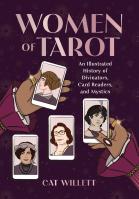Marie-Anne Lenormand, the Paris Sybil: An Excerpt from “Women of Tarot” by Cat Willett

Dear Readers, explore the unsung stories of the women who made Tarot, once reserved only for the upper-class, a tool for anyone to use.
Author Cat Willett first dove into artist Pamela Colman Smith’s life story with her illustrated biography The Queen of Wands: The Story of Pamela Colman Smith, the Artist Behind the Rider-Waite Tarot Deck. In the course of her research, she uncovered fifteen more women who were integral to tarot and mysticism’s evolution. Those stories are now compiled in Women of Tarot: An Illustrated History of Divinators, Card Readers, and Mystics.
Here we offer you Cat’s Introduction plus the chapter on Marie-Anne Lenormand, dubbed the Paris Sybil, the city’s first female celebrity card reader and the inspiration for the production of the iconic Lenormand deck. Happy reading!

Introduction
This book has been a labor of love and exploration—one that grew out of another project that has meant so much to me for many years. Through my work on The Queen of Wands, in which I highlighted the life and work of Pamela Colman Smith, I discovered many fascinating stories about women in the world of tarot, mysticism, and fortune-telling that span global history. What began as an exclusive card game reserved for the male elite has since grown into a tool of empowerment for people of all genders and walks of life. This profound evolution in the history of the cards and their use can be traced back to four key women and their efforts to make the realm of tarot more accessible to all. Moreover, these women have built off of each other’s work, with their lives, philosophies, practices, and art often overlapping. My motivation behind telling their stories comes from my passion for surfacing historical women who accomplished incredible things but have not yet been celebrated. In addition to readers, tarot artists, and card experts, you will also discover other types of magical women in these pages. Mystics, fortune tellers, priestesses—women who lived outside of the spiritual conventions of their time and contributed to the overall world of mysticism. I hope that the following history of tarot, told through the lens of the women who’ve made it what it is today, honors their collective belief that there is more to life than what meets the eye and that magic is real.

Marie-Anne Lenormand (1772-1843)
Born in 1772 in Alençon in the Normandy region of France, Marie-Anne Lenormand was orphaned at a very young age. Her mother’s death, followed shortly by her father’s, resulted in stepparents taking over the care of six-year-old Marie-Anne and her two siblings. The young girl was said to be temperamental and disobedient, prompting her guardians to eventually relinquish her care to the nuns at a Benedictine convent.
It wasn’t long after being sent to the convent that Marie-Anne began to show signs of clairvoyance. She was able to make prophetic predictions for her classmates, many of which would actually come to pass. She even accurately foretold that a nun discharged for wrongdoing would be replaced by a new nun selected by the king of France. Her premonitions prompted punishment and retribution from the nuns in charge. Her prophecies were interpreted as mischief by her elders, and the young child was disciplined with a meager diet of bread and water.
When Marie-Anne was fourteen, her stepmother could no longer financially support her private Benedictine education. As a result, Marie-Anne was instructed to support herself as a seamstress’s apprentice. But with no talent or patience for tailoring clothing, the young, rebellious teen packed her bags and set out for Paris on her own. It was around this time that Marie-Anne allegedly received her first tarot deck from Romani travelers. After finding out how to read the deck from them, she became immersed in the fascinating world of cartomancy, though she still had a great deal left to learn.

She found employment in Paris as a salesclerk and learned arithmetic. With that knowledge, Lenormand began to view numbers in a different light, becoming very interested in what kind of meaning she could glean from them outside of mathematics. This intrigue later played a role in her ability to read cards and explore numerology. Her calculating skills also secured her a mentorship in London with Franz Joseph Gall, a doctor who founded the very problematic pseudo-science of phrenology. Phrenology involved the study of the brain and the incorrect assumption that the shape and size of one’s skull could predict personality traits. Nevertheless, the German physician was gaining a lot of traction for his practices at the time, and he was impressed by Lenormand’s intelligence. He proclaimed that she was to be a great oracle and agreed to use his fame to help her secure new clients to launch her prophetic business. It’s unclear how involved the budding young fortune teller was with the practice of phrenology, but it appears that she willingly took Gall’s contacts and then moved on to build her own clientele.
Upon her arrival back in Paris in 1790, Lenormand got a job with a royalist before opening a shop of her very own on the wealthy Rue de Tournon. Here, her salon offered fortune-telling, card reading, and a bookshop, where she worked full-time and gained popularity—and notoriety—for her abilities. It became routine for Lenormand to find herself held in jail overnight, with the police and the general public always a bit skeptical of her occupation. But she would always be released the next morning.
To understand Lenormand’s rise to fame, it’s important to consider the political and cultural climate of France in the late 1700s and early 1800s. The French Revolution stretched from 1789 to 1799, comprising ten years of great change coupled with unrest, violence, and upheaval. The spread of new ideas that ultimately led to democracy also came with public executions, poverty, and an economic depression. What’s now known as the Reign of Terror stormed through the nation as leaders attempted to weed out counterrevolutionaries, culminating in nearly 17,000 executions. People were scared, hungry, unsettled, and looking for guidance. Keeping this in mind, it’s easy to see why Parisians—especially members of the upper class and nobles—came to Lenormand for answers.

Through cartomancy, astrology, palmistry, and other methods of divination, Lenormand sought to establish fortune-telling as a science, and she was very judicious about how certain practices would be regarded by the public. It was when she foretold the beheading of King Louis XVI in 1793 and the fall of the monarchy that she really began to cement herself as a reliable and respected source of information. Raised by royalist parents, Lenormand was loyal to the monarchy and even allegedly sought to save Marie Antoinette from the same fate as her husband. By disguising herself as a maid delivering a basket of fruit to the imprisoned queen, Lenormand was admitted into the prison where Marie Antoinette was kept. However, the queen of France was too shocked and afraid to run and ultimately faced her own execution nine months after her husband’s. Lenormand seemingly emerged unscathed from the attempted jailbreak, except for a brief stint in prison.
As she continued to practice fortune-telling, Lenormand established herself as an oracle for people of all walks of life, but especially for the French noble class. She was a secret source of stability for the wealthy, who, at this chaotic time in history, feared for their lives and positions in society yet needed to maintain an air of external confidence. Whether they heeded her advice or not, Lenormand’s chamber was a source of comfort for those who felt death on their doorstep.
Lenormand eventually became the personal tarot reader of Napoleon I’s wife Joséphine Bonaparte. Their relationship began before Joséphine was crowned empress, when she was still just a wealthy young aristocrat in need of divine insight. Though Joséphine and her first husband were being targeted as enemies of the revolution, Lenormand assured her that she would survive the guillotine and go on to marry a soldier who would achieve great success—her husband’s outlook was not so rosy. Two years later, Joséphine found herself married to Napoleon and on her way to becoming the empress of France. With this accurate prediction behind her, Joséphine’s confidence in her fortune teller grew, and she continued to seek counsel from Lenormand, who is said to have predicted the royal couple’s divorce, as well as Napoleon’s ultimate collapse—much to the emperor’s disapproval. Her interference in the royal relationship led to another stint in prison, a punishment to which she was no stranger by this point.

Though she remained active for several more decades and built quite a reputation, Lenormand eventually retired. During her later years, she still conducted secret readings out of her bookshop on the Rue de Tournon, where she welcomed clients with a variety of needs. She is said to have embodied a slightly unsightly charm as she aged—very petite with intense eyes, a blonde wig, and an intimidating mystique. Some say her reading chambers were decorated with taxidermied animals, reptiles preserved in bottles, and skeletons, all of which evoked an occult vibe that surely set the mood for her wary clients. Strangely enough, others describe the room as free from cliché or superstitious decor and quite bare.
Lenormand resisted the most common path for women at the time, choosing to never marry or sacrifice her career to bear children. In her older age, she is said to have adopted her sister’s two children, after her sister had passed away and she herself had amassed enough wealth that she could ultimately leave a fortune to her nephew. Over her fifty years working as an oracle for the people of France, as well as clients who came to see her from across Europe, she was dubbed the Paris Sibyl. While it’s important to remember that many of her stories of success come from her own writing—and therefore we must take them with a grain of salt—it’s clear that Lenormand paved the way for many female fortune tellers to come. During her lifetime, she was both respected and hated, but regardless of how people viewed her personally, her impact was indisputable. She wrote thirteen books chronicling her experiences, advised countless patrons, and made clairvoyant practices more accessible to the masses. After her death in 1843 at the age of seventy-two, her legacy as Paris’s first female celebrity card reader inspired the production of the Lenormand deck. This iconic deck bearing her name remains in circulation today. The reading of such decks is a bit different from our standard tarot cards, yet they are part of the same family of card divination.

Dive Deeper
Enjoyed this excerpt? Order Women of Tarot to discover magical contributions from these incredible women, too:
- Nefertiti
- Harriet Wilson
- Helena Petrovna Blavatsky
- Moina Mathers
- Teresa Urrea
- Pamela Colman Smith
- Marie Catherine Laveau
- Zora Neale Hurston
- Lady Frieda Harris
- Ma Prem Usha
- Eden Gray
- Mary K. Greer
- Rachel Pollack
- Nanse Kawashima
- Grace Selene







